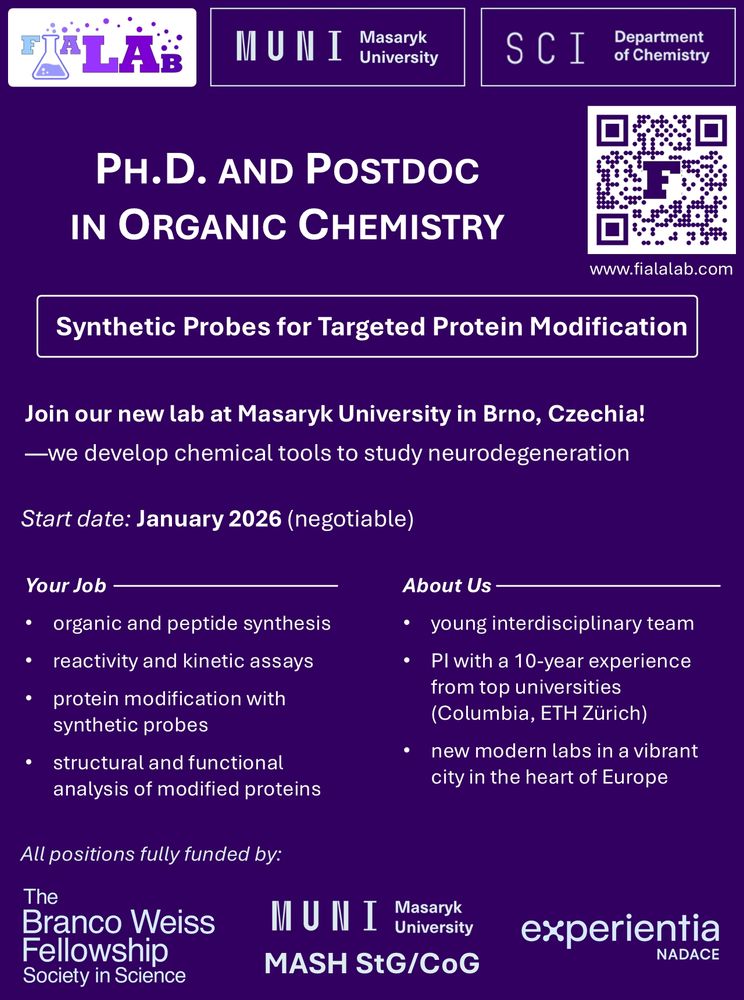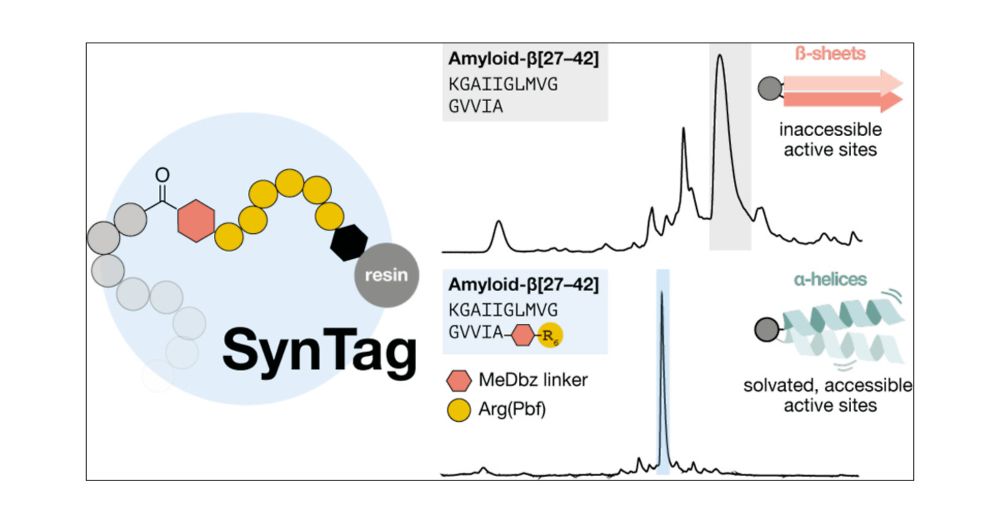
ChemiCator
Welcome to ChemiCator!
🔬 Dive Deep into the Fascinating World of Organic Chemistry 🔬
Are you passionate about organic chemistry? Whether you're a student striving for excellence, a curious mind eager...
I believe communicating science and sparking interest in others is as important as doing the actual research. If you love organic chemistry, check out the Chemicator channel on Youtube! Beautiful graphics and nice explainers from an enthusiastic student.
www.youtube.com/@Chemicator
03.10.2025 07:34 — 👍 2 🔁 0 💬 0 📌 0

Mass spectrometry and enzyme assays refute histone tyrosine sulfation - Nature Chemical Biology
Nature Chemical Biology - Mass spectrometry and enzyme assays refute histone tyrosine sulfation
TWeeP (This Week's Paper): The PTM sulfotyrosine is very hard to reliably identify due to instability and similarity to phosphoTyr. This week, I highlight a vivid debate in @natchembio.nature.com about the existence of sTyr in histones:
www.nature.com/articles/s41...
www.nature.com/articles/s41...
07.09.2025 21:06 — 👍 0 🔁 0 💬 0 📌 0

⭐🎉 Přinášíme skvělou zprávu a další obrovský úspěch! Tomáš Fiala, držitel Start-up grantu Nadace Experientia, získal prestižní ERC Starting grant pro mladé vědce! Svoji výzkumnou skupinu založí v říjnu 2025 na @masarykuniversity.bsky.social.
Tomášovi k tomuto úspěchu srdečně gratulujeme! 👏
04.09.2025 10:55 — 👍 3 🔁 1 💬 0 📌 0
TWeeP (This Week's Paper): Hemes are ubiquitous in nature. Yet, their trafficking and dynamics remain underexplored. That's about to change thanks to probes that label neighboring proteins upon activation by heme from Hirayama and coworkers in @jacs.acspublications.org!
pubs.acs.org/doi/full/10....
02.08.2025 12:04 — 👍 2 🔁 0 💬 0 📌 0
TWeeP (This Week's Paper): another fantastic publication from the Kanai lab in @jacs.acspublications.org. Check out how to generate isocyanates on demand from a stable hydroxamic acid–pyrrolidine conjugate and sulfonyl fluoride for fast protein labeling in live cells!
pubs.acs.org/doi/10.1021/...
27.07.2025 11:31 — 👍 2 🔁 0 💬 0 📌 0

We have multiple PhD and Postdoc positions open in my new group at Masaryk University. Are you an excellent and motivated candidate interested in organic and peptide synthesis and chemical biology? Get in touch! Start in January 2026. www.fialalab.com
Appreciate sharing!
21.07.2025 15:37 — 👍 9 🔁 6 💬 0 📌 1

Nadace Experientia zná držitele start-up grantu pro rok 2025!
👨🔬 Tomáš Fiala, který aktuálně působí na ETH Zürich, založí svoji výzkumnou skupinu na Masarykově univerzitě v Brně, kterou od ledna 2026 podpoří start-up grant Nadace Experientia ve výši 6 000 000 Kč.
Moc gratulujeme!
18.06.2025 07:00 — 👍 4 🔁 1 💬 0 📌 0

Selectively assembling collagen heterotrimers is a challenge. But not for us! Aminopropline-aspartate salt bridges drive the assembly of a hyperstable, a minimal-length, and a special blunt-ended collagen heterotrimer. Now out in
@angewandtechemie.bsky.social!
onlinelibrary.wiley.com/doi/10.1002/...
09.05.2025 15:11 — 👍 7 🔁 1 💬 0 📌 1

Hyperstable and Fibril-Forming Collagen-Mimetic Peptides in Shortest Triple Helices: Empowering the Capping by π-systems
Developing collagen-mimetic peptides (CMPs) with short triple helices and fibril-forming ability remains challenging. Herein, we stabilized short CMPs (3–6 GPO repeats) by attaching extended aromatic π-system─fluorenyl groups at the N-terminus and tyrosine at the C-terminus. These modifications promoted triple helix folding through π–π interactions, acting as a “glue” to stabilize the structure and facilitate fibrillation. A single fluorenyl cap required 5 GPO repeats for helix formation, while double fluorenyl capping reduced this to 4 repeats. Notably, at pH 5.5, triple helices formed with only 3 GPO repeats. The double-capped CMPs exhibited hyperstability (Tm = 76 °C) and formed fibrillar networks at physiological pH. Biophysical and computational studies confirmed the role of π–π and CH–π interactions, along with hydrogen bonding, in stabilization. The minimalistic CMPs supported cell viability, demonstrating their potential for biomedical applications. This strategy offers a method to design highly stable, short CMPs that form robust fibrillar networks.
TWeeP (This Week's Paper): In Biomacromolecules, Mukherjee et al. present a neat way of stabilizing collagen triple helices and inducing their fibrillation via terminal aromatic capping groups. (Plus check out the fun TOC graphic!!)
pubs.acs.org/doi/abs/10.1...
30.03.2025 20:44 — 👍 0 🔁 0 💬 0 📌 0
Laboratory of Stem Cell Biology and Vision Research
Faculty of Medicine, Masaryk University, Czech Republic.
Research, news, and information from the Journal of the American Chemical Society: pubs.acs.org/JACS
Professor of Chemistry, Columbia University @columbiauniversity.bsky.social
Research: Physical Macromolecular Chemistry
Associate Editor: Chemical Science @chemicalscience.rsc.org
www.somoscampos.org
🇲🇽🇺🇸 (he/him)
Research group at IOCB Prague and Charles University working in bioorganic and medicinal chemistry of nucleic acids and their components. http://hocekgroup.uochb.cas.cz/
How does cell size affect stem cell function?
Assistant Professor at Helsinki University 🇫🇮 and Karolinska Institutet 🇸🇪 StemCellSIZE - ERC_Research. Alumni @MIT @ETH
http://lengefeldlab.com
Assistant Professor of Medicinal Chemistry at ETH Zürich
Self-assembled materials
Postdoc in the Wennemers Group, ETHZ
PhD in the Rickhaus Group, UZH
Podporujeme mladé vědkyně a vědce z oboru organické, bioorganické a medicinální chemie díky zahraničním stážím a vědeckým start-up grantům. Českou chemii rozvíjíme i podporou učitelů chemie a mladých chemických talentů.
Junior PI at #FUBerlin in Organic Chemistry. More info: https://www.bcp.fu-berlin.de/en/chemie/chemie/forschung/OrgChem/haut/index.html
https://www.unimedizin-mainz.de/medizinische-mikrobiologie-und-hygiene/
#DGfI #DGHM #EFIS #IUIS / 🦖☄️🦠🔬🧫🐁🧍/ #immunometabolism / #host-pathogen interaction / 🇪🇺 / #UM #JGU: excellence in basic research and health care / own views only
Flagship journal for @rsc.org, open access with no publication fee, all topics in chemistry. chemicalscience-rsc@rsc.org
Celebrating our 15th year in 2025! 🌐 Website: rsc.li/chemscience
Professor of Organic Chemistry at the University of Edinburgh
PhD Student at ETH Zürich
Research group leader at ETH Zurich passionate about organic chemistry and science in general. Outside work I enjoy parenting, listening to music (percussionist) and travelling to sunny places with good food.
An open access @NaturePortfolio journal publishing high-quality primary research articles, reviews and commentary in all areas of the chemical sciences.
nature.com/commschem/
The Wennemers Group @ethzurich.bsky.social uses organic synthesis to tackle challenges in asymmetric catalysis, chemical biology, new synthetic materials and metal nanoparticles.
Student-run account. Posts by Helma signed HW.
www.wennemers.ethz.ch
























